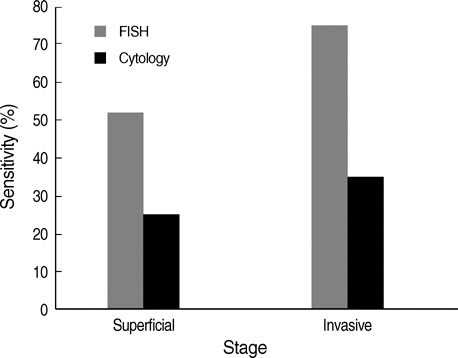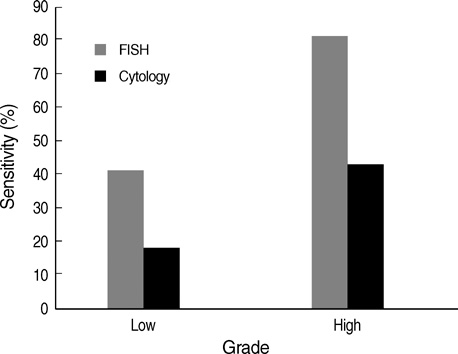J Korean Med Sci.
2009 Dec;24(6):1139-1144. 10.3346/jkms.2009.24.6.1139.
The Utility of Fluorescence In Situ Hybridization for Detection of Bladder Urothelial Carcinoma in Routine Clinical Practice
- Affiliations
-
- 1Department of Urology, KEPCO (Korea Electric Power Corporation) Medical Foundation, Hanil General Hospital, Seoul, Korea.
- 2Department of Laboratory Medicine, Samsung Medical Center, Sungkyunkwan University School of Medicine, Seoul, Korea.
- 3Department of Urology, Samsung Medical Center, Sungkyunkwan University School of Medicine, Seoul, Korea. besthml@medimail.co.kr
- KMID: 1783145
- DOI: http://doi.org/10.3346/jkms.2009.24.6.1139
Abstract
- To evaluate the ability of fluorescence in situ hybridization (FISH) in detecting bladder urothelial carcinoma (BUC), FISH and cytology were compared for the evaluation of 308 consecutive urine samples from patients suspected of having BUC. All patients underwent cystoscopy for identification of bladder lesions. The FISH results were compared with the cytology assessment. In all, 122 patients had confirmed BUC. Among them, 68 (55.7%) were FISH-positive, while only 33 (27%) were positive on cytology. According to disease stage (superficial vs. invasive) and grade (low vs. high), the sensitivities of FISH were also significantly higher than those of cytology in all categories. Moreover, in 36 patients who had no visible tumor with flat, erythematous mucosa (suspicious lesion), FISH was more sensitive than cytology for the detection of BUC (83.3% vs. 33.3%, P=0.002). The FISH was negative in 168 (90.3%) of 186 patients with no histological evidence of BUC or negative cystoscopy findings. The sensitivity of FISH for detecting BUC was superior to that of cytology, regardless of tumor stage and grade. FISH is a significant additional and complementary method for detection of BUC in patients who have suspicious lesions on cystoscopy.
MeSH Terms
Figure
Cited by 1 articles
-
The Relationship between the Presence of Chromosomal Instability and Prognosis of Squamous Cell Carcinoma of the Lung: Fluorescence in situ Hybridization Analysis of Paraffin-embedded Tissue from 47 Korean Patients
Jung-Wan Yoo, Kwang Won Seo, Se Jin Jang, Yeon-Mock Oh, Tae Sun Shim, Woo Sung Kim, Dong-Soon Lee, Sang-Do Lee, Chang-Min Choi
J Korean Med Sci. 2010;25(6):863-867. doi: 10.3346/jkms.2010.25.6.863.
Reference
-
1. Raghavan D, Shipley WU, Garnick MB, Russell PJ, Richie JP. Biology and management of bladder cancer. N Engl J Med. 1990. 322:1129–1138.
Article2. Maier U, Simak R, Neuhold N. The clinical value of urinary cytology: 12 years of experience with 615 patients. J Clin Pathol. 1995. 48:314–317.
Article3. Konety BR, Getzenberg RH. Urine based markers of urological malignancy. J Urol. 2001. 165:600–611.
Article4. Lokeshwar VB, Soloway MS. Current bladder tumor tests: does their projected utility fulfill clinical necessity? J Urol. 2001. 165:1067–1077.
Article5. Glas AS, Roos D, Deutekom M, Zwinderman AH, Bossuyt PM, Kurth KH. Tumor markers in the diagnosis of primary bladder cancer. A systematic review. J Urol. 2003. 169:1975–1982.
Article6. Lotan Y, Roehrborn CG. Sensitivity and specificity of commonly available bladder tumor markers versus cytology: results of a comprehensive literature review and meta-analyses. Urology. 2003. 61:109–118.
Article7. Sokolova IA, Halling KC, Jenkins RB, Burkhardt HM, Meyer RG, Seelig SA, King W. The development of a multitarget, multicolor fluorescence in situ hybridization assay for the detection of urothelial carcinoma in urine. J Mol Diagn. 2000. 2:116–123.
Article8. Zellweger T, Benz G, Cathomas G, Mihatsch MJ, Sulser T, Gasser TC, Bubendorf L. Multi-target fluorescence in situ hybridization in bladder washings for prediction of recurrent bladder cancer. Int J Cancer. 2006. 119:1660–1665.9. Mao L, Schoenberg MP, Scicchitano M, Erozan YS, Merlo A, Schwab D, Sidransky D. Molecular detection of primary bladder cancer by microsatellite analysis. Science. 1996. 271:659–662.
Article10. Halling KC, King W, Sokolova IA, Meyer RG, Burkhardt HM, Halling AC, Cheville JC, Sebo TJ, Ramakumar S, Stewart CS, Pankratz S, O'Kane DJ, Seelig SA, Lieber MM, Jenkins RB. A comparison of cytology and fluorescence in situ hybridization for the detection of urothelial carcinoma. J Urol. 2000. 164:1768–1775.
Article11. Placer J, Espinet B, Salido M, Sole F, Gelabert-Mas A. Clinical utility of a multiprobe FISH assay in voided urine specimens for the detection of bladder cancer and its recurrences, compared with urinary cytology. Eur Urol. 2002. 42:547–552.
Article12. Marin-Aguilera M, Mengual L, Ribal MJ, Burset M, Arce Y, Ars E, Oliver A, Villavicencio H, Algaba F, Alcaraz A. Utility of a multiprobe fluorescence in situ hybridization assay in the detection of superficial urothelial bladder cancer. Cancer Genet Cytogenet. 2007. 173:131–135.13. Halling KC, King W, Sokolova IA, Karnes RJ, Meyer RG, Powell EL, Sebo TJ, Cheville JC, Clayton AC, Krajnik KL, Ebert TA, Nelson RE, Burkhardt HM, Ramakumar S, Stewart CS, Pankratz VS, Lieber MM, Blute ML, Zincke H, Seelig SA, Jenkins RB, O'Kane DJ. A comparison of BTA stat, hemoglobin dipstick, telomerase and Vysis UroVysion assays for the detection of urothelial carcinoma in urine. J Urol. 2002. 167:2001–2006.
Article14. Sarosdy MF, Schellhammer P, Bokinsky G, Kahn P, Chao R, Yore L, Zadra J, Burzon D, Osher G, Bridge JA, Anderson S, Johansson SL, Lieber M, Soloway M, Flom K. Clinical evaluation of a multitarget fluorescent in situ hybridization assay for detection of bladder cancer. J Urol. 2002. 168:1950–1954.
Article15. Raitanen MP, Marttila T, Kaasinen E, Rintala E, Aine R, Tammela TL. Sensitivity of human complement factor H related protein (BTA stat) test and voided urine cytology in the diagnosis of bladder cancer. J Urol. 2000. 163:1689–1692.
Article16. Boman H, Hedelin H, Holmang S. Four bladder tumor markers have a disappointingly low sensitivity for small size and low grade recurrence. J Urol. 2002. 167:80–83.
Article17. Bhuiyan J, Akhter J, O'Kane DJ. Performance characteristics of multiple urinary tumor markers and sample collection techniques in the detection of transitional cell carcinoma of the bladder. Clin Chim Acta. 2003. 331:69–77.
Article18. Bubendorf L, Grilli B, Sauter G, Mihatsch MJ, Gasser TC, Dalquen P. Multiprobe FISH for enhanced detection of bladder cancer in voided urine specimens and bladder washings. Am J Clin Pathol. 2001. 116:79–86.
Article19. Junker K, Fritsch T, Hartmann A, Schulze W, Schubert J. Multicolor fluorescence in situ hybridization (M-FISH) on cells from urine for the detection of bladder cancer. Cytogenet Genome Res. 2006. 114:279–283.
Article20. Raitanen MP, Kaasinen E, Lukkarinen O, Kauppinen R, Viitanen J, Liukkonen T, Tammela TL. Analysis of false-positive BTA STAT test results in patients followed up for bladder cancer. Urology. 2001. 57:680–684.
Article21. Pycha A, Mian C, Hofbauer J, Haitel A, Wiener H, Marberger M. Does topical instillation therapy influence chromosomal aberrations in superficial bladder cancer? J Urol. 1998. 159:265–269.
Article22. Friedrich MG, Toma MI, Hellstern A, Pantel K, Weisenberger DJ, Noldus J, Huland H. Comparison of multitarget fluorescence in situ hybridization in urine with other noninvasive tests for detecting bladder cancer. BJU Int. 2003. 92:911–914.
Article
- Full Text Links
- Actions
-
Cited
- CITED
-
- Close
- Share
- Similar articles
-
- Comparison of the Efficacy of Urine Cytology and Fluorescence in Situ Hybridization (FISH) for the Detection of Bladder Urothelial Carcinoma
- Photodynamic Diagnosis(PDD) following Intravesical Instillation of 5-aminolevulinic acid(ALA) for Detection of Neoplastic Urothelial Lesions
- Clinical Utility of Fluorescence in Situ Hybridization for Voided Urine for the Diagnosis and Surveillance of Bladder Cancer
- Seminal Vesicle Involvement by Urothelial Carcinoma in Situ of the Bladder with Mucosal Spread Pattern: A Case Report
- Comparison of the Efficacy of Urine Cytology, Nuclear Matrix Protein 22 (NMP22), and Fluorescence in Situ Hybridization (FISH) for the Diagnosis of Bladder Cancer





